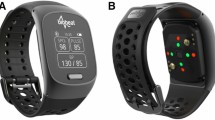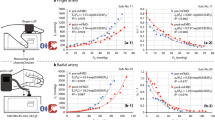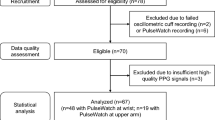Abstract
Background: Devices that record from the finger have potential practical advantages for home monitoring of blood pressure. However, digital arterial pressure may vary substantially from that in the brachial artery, due to the influence of peripheral wave reflection.
Aims: (1) To compare digital arterial pressure, as measured with the Omron F3 device, with brachial arterial pressure and (2) to determine the effect on digital pressure of changing local vascular resistance.
Method: The subjects were normotensive young adult non-smokers (12 males, 14 females). Pressures were recorded simultaneously from arm (using an Omron HEM-705CP) and finger with subjects seated and both recording sites at the level of the xiphisternum. Measurements were made at ambient temperatures of 19°C and 30°C; at rest, during brief contralateral hand cooling and after hand rewarming.
Results: In many cases, resting finger values differed substantially from arm values; sometimes by 20 mm Hg or more. The extent of individual variations was not correlated with gender or temperature. However, group pressure differences between the sites were greater in females at ovulation than at menstruation and greater at 30°C than at 19°C. For all groups, pressure differences between sites were attenuated during hand cooling and restored by rewarming.
Conclusions: Finger blood pressure, as measured with the Omron F3, misestimates brachial blood pressure in a high proportion of normal subjects. This error is increased under circumstances associated with cutaneous vasodilation. The Omron F3 does not appear to be suitable for unsupervised home monitoring of blood pressure.
This is a preview of subscription content, access via your institution
Access options
Subscribe to this journal
Receive 12 digital issues and online access to articles
$119.00 per year
only $9.92 per issue
Buy this article
- Purchase on Springer Link
- Instant access to full article PDF
Prices may be subject to local taxes which are calculated during checkout
Similar content being viewed by others
References
Aylett M Use of home blood pressure measurements to diagnose ‘white coat hypertension’ in general practice J Hypertens 1996 10 17–20
Ramsay LE et alBritish Hypertension Society guidelines for hypertension management 1999: summary BMJ 1999 319 630–635
Imai Y et alPrognostic significance of self-measurements of blood pressure Blood Press Monit 2000 5 137–143
Kleinert HD et alWhat is the value of home blood presure measurement inpatients with mild hypertension? Hypertension 1984 6 574–578
Taylor MG Wave-travel in a non-unit uniform transmission line, in relation to pulses in arteries Phys Med Biol 1965 10 539–550
McDonald DA Blood Flow in Arteries Edward Arnold: London 1974
Nichols WW, O’Rourke MF Contour of Pressure and Flow Waves in Arteries Edward Arnold: London 1991 pp 216–250
London GM, Guérin A Influence of arterial pulse and reflective waves on systolic blood pressure and cardiac function J Hypertens 1999 17 S3–S6
Wesseling KH et alEffects of peripheral vasoconstriction on the measurement of blood pressure in a finger Cardiovasc Res 1985 19 139–145
O’Brien E, Mee F, Atkins N, Thomas M Self-measurement of blood pressure according to the Revised British Hypertension Society Protocol: the Omron HEM-705CP, Philips HP 5332 and Nissei DS-175 Blood Press Monit 1996 1 55–561
Folkow B et alStudies on the reactions of the cutaneous vessels to cold exposure Acta Physiol Scand 1963 58 342–354
Bland M, Altman DG Statistical methods for assessing agreement between two methods of clinical measurement Lancet 1986 1 307–310
Hayes B Sphygmomanometry. In: Hayes B (ed) Non-Invasive Cardiovascular Monitoring BMJ Publishing Group: London 1997 68–81
London GM et alInfluence of sex on arterial hemodynamics and blood pressure: role of body height Hypertension 1995 26 514–519
McAuley D, Silke B, Farrell S Reliability of blood pressure determination with the Finapres in altered physiological states or pharmacodynamic conditions Clin Autonom Res 1997 7 179–184
Hildebrandt W, Schutze H, Stegmann J On the reliability of the penaz cuff during systemic and local vasodilatation at rest and in exercise Eur J Appl Physiol 1991 62 175–179
Eckert S, Mannebach H, Gleichmann U Validation of the Omron F3 blood pressure measuring device for use in the finger through simultaneous invasive comparative measurements according to the German Institute for Validation (DIN) 58130 protocol Blood Press Monit 1998 3 347–351
Gangar KF et alPulsatility index in internal carotid artery in relation to transdermal oestradiol and time since menopause Lancet 1991 338 839–842
Giannattasio C et alFluctuations of radial artery distensibility throughout the menstrual cycle Arterioscl Thromb Vasc Biol 1999 19 1925–1929
Westendorp IC et alMenopausal status and distensibility of the common carotid artery Arterioscl Thromb Vasc Biol 1999 19 713–717
Gilligan DM et alAcute vascular effects of estrogen in postmenopausal women Circulation 1994 90 786–791
Bartelink ML et alChanges in skin blood flow during the menstrual cycle: the influence of the menstrual cycle on the peripheral circulation in healthy female volunteers Clin Sci 1990 78 527–532
Volterrani M et alEstrogen acutely increases peripheral blood flow in postmenopausal women Am J Med 1995 99 119–122
Parati G et alComparison of finger and intra-arterial blood pressure monitoring at rest and during laboratory testing Hypertension 1989 13 647–655
Tanaka H, Thulesius O Effect of temperature on finger artery pressure evaluated by volume-clamp technique Clin Physiol 1993 13 535–545
O'Shea JC, Murphy MB Ambulatory blood pressure monitoring: which arm? J Hum Hypertens 2000 14 227–230
Gould BA et alIs the blood pressure the same in both arms? Clin Cardiol 1985 8 423–426
Author information
Authors and Affiliations
Corresponding author
Rights and permissions
About this article
Cite this article
Tansey, E., Bell, C. Evaluation of digital blood pressure measured with the Omron F3 device as an index of brachial arterial pressure, under different thermal and hormonal conditions. J Hum Hypertens 15, 593–600 (2001). https://doi.org/10.1038/sj.jhh.1001238
Received:
Revised:
Accepted:
Published:
Issue Date:
DOI: https://doi.org/10.1038/sj.jhh.1001238



